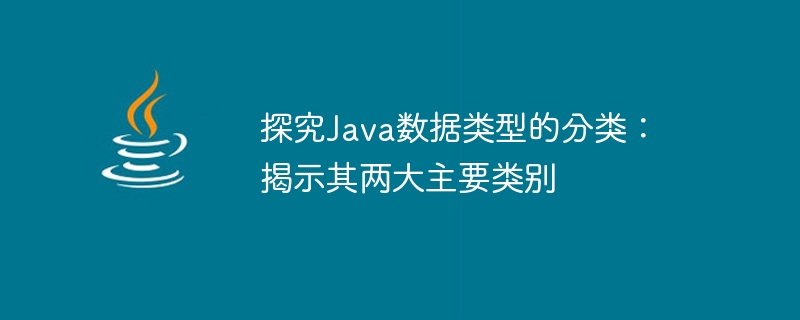 Java
Java
 javaTutorial
javaTutorial
 Exploring the classification of Java data types: revealing their two main categories
Exploring the classification of Java data types: revealing their two main categories
Exploring the classification of Java data types: revealing their two main categories

Exploring the classification of Java data types: revealing its two main categories
Java is an object-oriented programming language with rich data types to support different types data storage and processing. In Java, data types can be divided into two main categories: basic data types and reference data types. This article will delve into these two categories and demonstrate their characteristics and application scenarios through specific code examples.
1. Basic data types
The basic data types of Java are the basic units used to represent simple data. There are eight basic data types: byte, short, int, long, float, double, char and boolean. Their characteristics are: they occupy a fixed memory space, and different types have different value ranges and precisions. The following is a brief introduction and code examples of each basic data type:
- byte (byte type): occupies 1 byte, and the value range is -128 to 127.
byte myByte = 100; System.out.println(myByte);
- short (short integer): occupies 2 bytes, and the value range is -32768 to 32767.
short myShort = 10000; System.out.println(myShort);
- int (integer): occupies 4 bytes, and the value range is -2147483648 to 2147483647.
int myInt = 1000000; System.out.println(myInt);
- long (long integer): occupies 8 bytes, and the value range is -9223372036854775808 to 9223372036854775807.
long myLong = 100000000000L; System.out.println(myLong);
- float (single-precision floating point type): occupies 4 bytes, the value range is -3.40282347E 38 to 3.40282347E 38, and the precision is 6-7 decimal places.
float myFloat = 3.14f; System.out.println(myFloat);
- double (double-precision floating point type): occupies 8 bytes, the value range is -1.79769313486231570E 308 to 1.79769313486231570E 308, and the precision is 15 decimal places.
double myDouble = 3.14159265359; System.out.println(myDouble);
- char (character type): occupies 2 bytes and is used to represent Unicode characters.
char myChar = 'A'; System.out.println(myChar);
- boolean (Boolean): occupies 1 byte, and the value is true or false.
boolean myBoolean = true; System.out.println(myBoolean);
Basic data types are suitable for storing and processing simple data, such as numbers, characters, and Boolean values. They store the value of data directly in memory and are therefore more efficient.
2. Reference data types
Reference data types refer to non-basic types of data. They store references (addresses) to data. In Java, reference data types include: classes, interfaces, arrays, etc. Reference data types do not have a fixed size; the size depends on the size and complexity of the object being referenced. The following is an introduction and code examples of some common reference data types:
- Class:
class Person {
String name;
int age;
}
Person person = new Person();
person.name = "John";
person.age = 25;
System.out.println(person.name + " " + person.age);- Interface:
interface Animal {
void eat();
}
class Dog implements Animal {
public void eat() {
System.out.println("狗吃骨头");
}
}
Dog dog = new Dog();
dog.eat();- Array:
int[] myArray = {1, 2, 3, 4, 5};
System.out.println(myArray[0]);The reference data type is suitable for storing and processing more complex data structures, such as class objects, interface implementations, and arrays. They point to objects in memory by reference, allowing the creation and manipulation of more flexible and advanced data structures.
Summary:
This article delves into the classification of Java data types and reveals its two main categories: basic data types and reference data types. Basic data types are suitable for storing and processing simple data, while reference data types are suitable for storing and processing more complex data structures. Through specific code examples, readers can have a clearer understanding of the characteristics and application scenarios of these two categories.
The above is the content of this article, I hope it will be helpful to readers. Thanks for reading!
The above is the detailed content of Exploring the classification of Java data types: revealing their two main categories. For more information, please follow other related articles on the PHP Chinese website!

Hot AI Tools

Undresser.AI Undress
AI-powered app for creating realistic nude photos

AI Clothes Remover
Online AI tool for removing clothes from photos.

Undress AI Tool
Undress images for free

Clothoff.io
AI clothes remover

AI Hentai Generator
Generate AI Hentai for free.

Hot Article

Hot Tools

Notepad++7.3.1
Easy-to-use and free code editor

SublimeText3 Chinese version
Chinese version, very easy to use

Zend Studio 13.0.1
Powerful PHP integrated development environment

Dreamweaver CS6
Visual web development tools

SublimeText3 Mac version
God-level code editing software (SublimeText3)

Hot Topics
 1384
1384
 52
52

